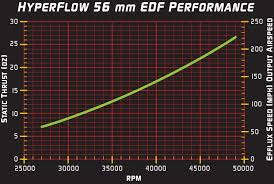I’ve obtained some promising results by using a total pressure inlet boundary condition with the compressible solver. Incompressible was not diverging, but results were all over the place, so I’m ignoring that for the moment. Both were using the default settings, so tweaking the numerics might help in the incompressible case.
Anyway, with compressible solver, results converged in 1000 iterations to the following values:
- Ux: 78.8 m/s
- p: 101425 Pa (100 Pa, relative)
Those results look reasonable to me. For comparison, I found the following chart—I presume it is for a similar type of fan—and results are of similar magnitude.
- 770 g → 27.1 oz
- 78.8 m/s → 176 mph
Reminder: link to project here.
